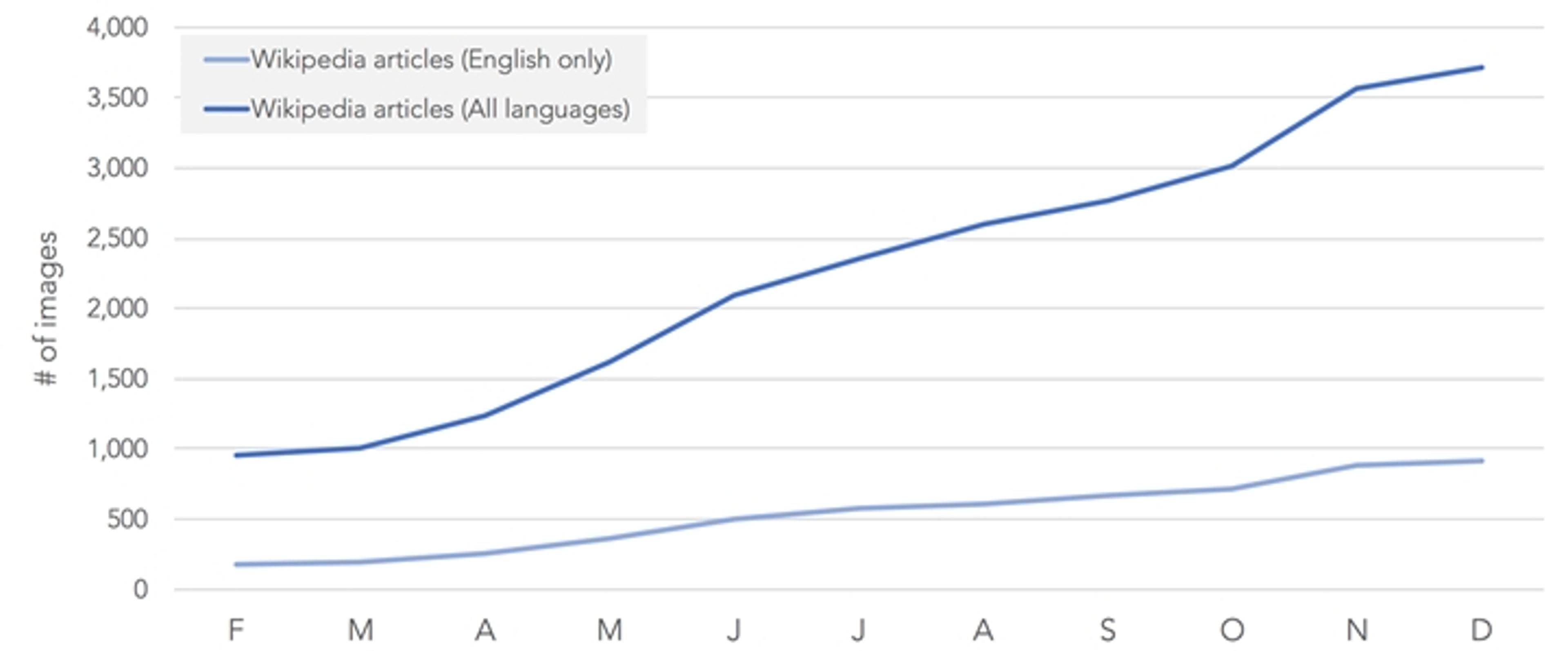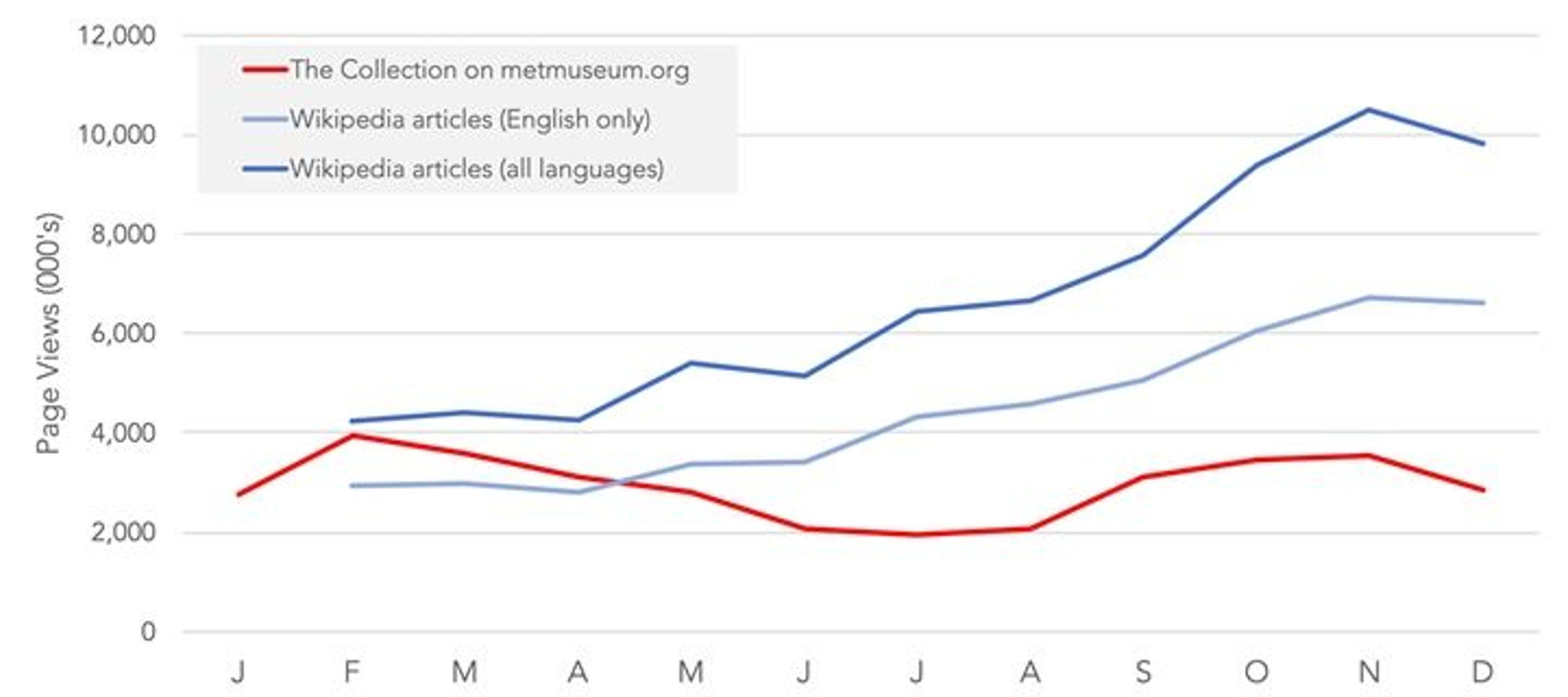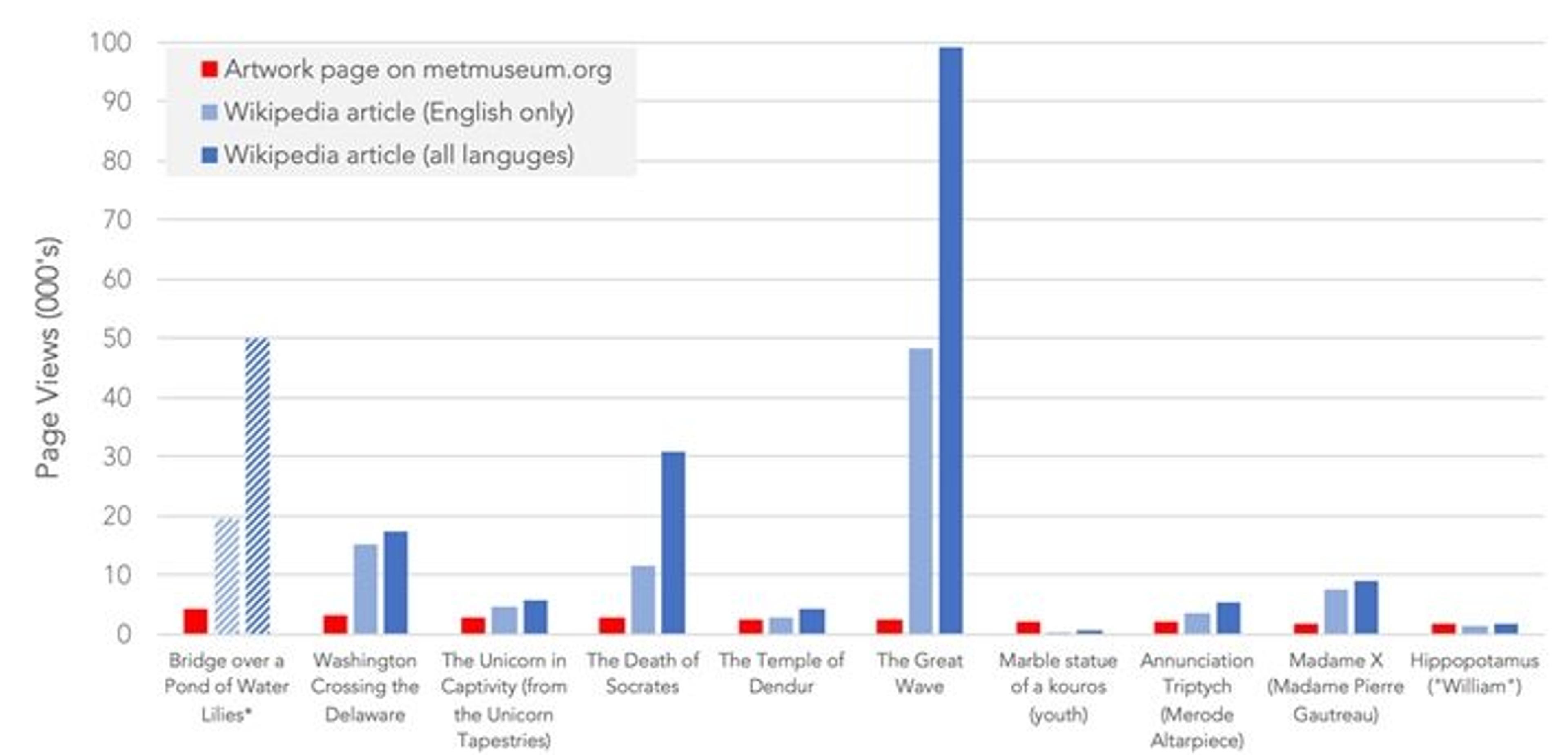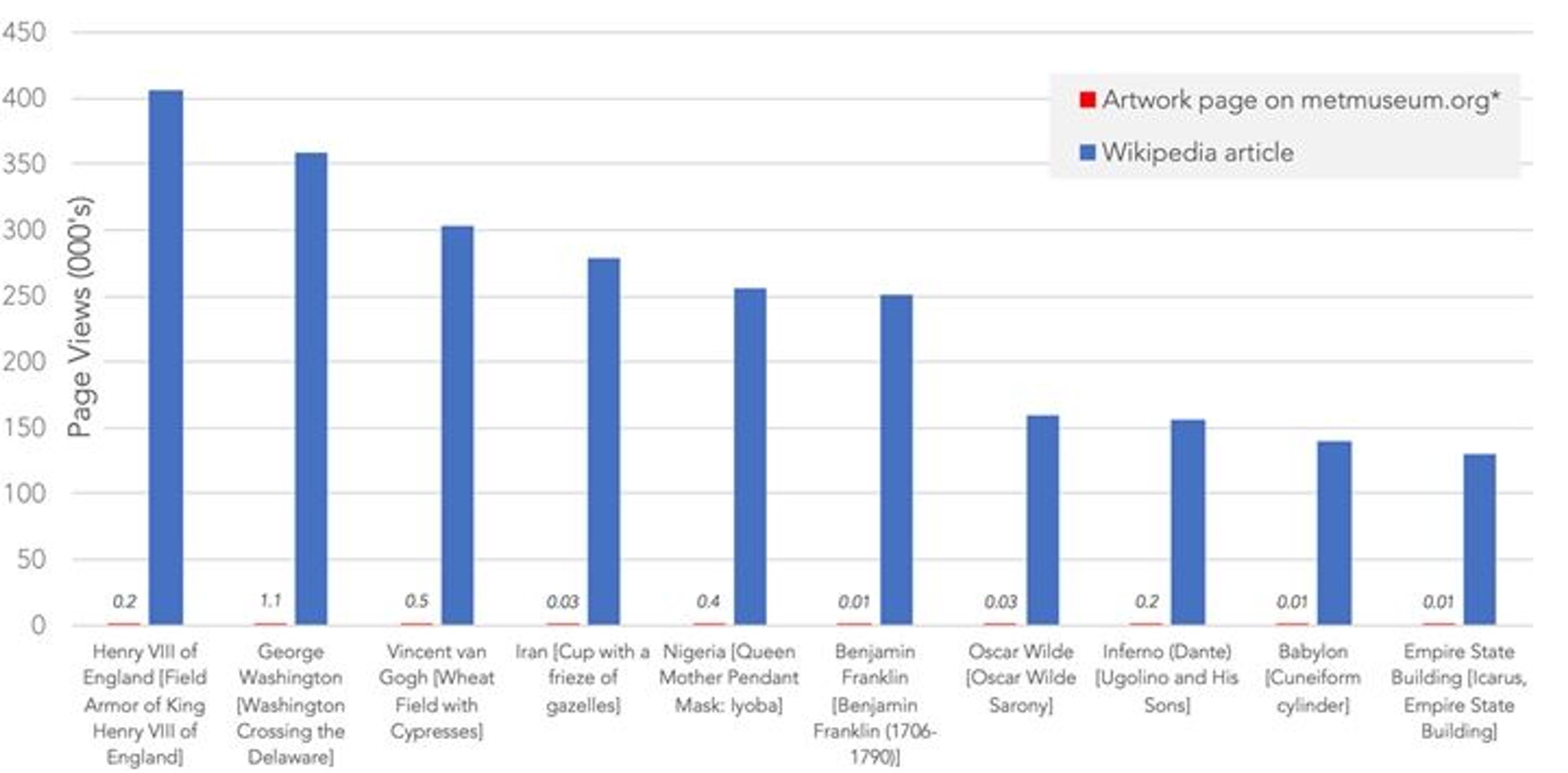Creating Access beyond metmuseum.org: The Met Collection on Wikipedia
«Since its launch one year ago today, The Met's Open Access initiative has become a foundational component of the Museum's digital future. It is changing audiences' relationship to The Met collection—software developer Simone Seagle's animation project is a recent, inspiring example—and helping to make the collection one of the most accessible on the internet. The initiative is also impacting us internally, reshaping how we approach the fulfillment of The Met's mission in the digital age.»
Spanning 5,000 years of human history, the Museum's comprehensive collection is relevant to audiences across the globe. There is an artwork in the collection that could inspire any one of the 3.9 billion internet-connected people in the world. Our goal is to reduce the distance between each of those people and the artwork that would inspire them, and Open Access is one of the major tactics to move us closer to that goal. With the initiative now one year young, it is interesting to take a moment to note the impact it has had.
Usage of the Online Collection on metmuseum.org
The Met's adoption of an Open Access licensing policy for images and data received attention from a number of international media outlets, which generated a significant increase in user activity in the online collection on metmuseum.org.[1] In the weeks following launch, we experienced a 21% increase in sessions (fig. 1), a 38% increase in pageviews (fig. 2), and an incredible 260% increase in image downloads (fig. 3).

Fig. 1. Number of sessions of online collection pages on metmuseum.org during 2016 and 2017

Fig. 2. Number of pageviews of online collection pages on metmuseum.org during 2016 and 2017
These dizzying peaks, however, reveal little about the sustained, longer-term impact we are seeking. A comparison of the data from the final three months of 2016 (pre–Open Access) and 2017 (eight months after the Open Access launch) provides a more accurate read. Over this period, the scorecard reads:
- Sessions on the Collection area of metmuseum.org: +3%
- Pageviews per session: +10%
- Number of image downloads: +69%
- Percentage of sessions that include an image download (fig. 4): +38%

Left: Fig. 3. Number of CC0 image downloads per month from the online collection. Right: Fig. 4. Percentage of sessions of the online collection in which the user downloaded one or more CC0 (Open Access) images
The comparatively small increase in sessions suggests that Open Access has had limited impact on bringing new audiences to the Museum's online collection. The longer-term impact of Open Access on the collection relates more to an increased depth of engagement by users; the increases to pageviews per sessions, the percentage of users that download an image, and the number of image downloads all indicate this is the case. This conclusion is supported by the fact that users who download an image are spending 16 minutes longer on the website than those that do not.
The Met Collection on Wikipedia
To look at the impact of the Open Access initiative only through the lens of metmuseum.org is to focus on just the tip of the iceberg. It is beyond our website that the impact of Open Access has been most compelling, and nowhere more so than through The Met's partnership with the Wikimedia Community and on Wikipedia—the free, open-content online encyclopedia, and one of the 10 most visited websites in the world.
Open Access enabled The Met—led by our first Wikimedian-in-Residence, Richard Knipel—to upload all 375,000-plus CC0 images of public-domain artworks in the Museum's collection to Wikimedia Commons, and to engage Wikimedians globally to add these images to new and existing Wikipedia articles. The interest has been incredible. In just one year, there has been a 385% increase in the visibility of The Met collection on Wikipedia (fig. 5). Nearly 4,000 images are now included in Wikipedia articles, and through these articles, the collection is reaching 10 million people per month (fig. 6)—quadruple the reach at the start of 2017, prior to Open Access.

Fig. 5. Increase in number of CC0 images of artworks in The Met collection that are included in Wikipedia articles during 2017

Fig. 6. Pageviews of the online collection, and pageviews of Wikipedia articles during 2017 that include a CC0 image of an artwork in The Met collection during 2017
The scale differential between the audience on metmuseum.org and Wikipedia is particularly apparent in a comparison of average monthly pageviews of the most popular artworks on The Met's website with that of the Wikipedia articles about the same artworks (fig. 7). On average, the reach is seven times larger on Wikipedia than on metmuseum.org.

Fig. 7. Average monthly pageviews (Q4 2017) of the 10 most viewed artwork pages on metmuseum.org and of the Wikipedia article related to the same artwork. *There is no Wikipedia article for Bridge over a Pond of Water Lilies; data for the related Wikipedia article, Water Lilies (Monet Series), is presented above instead.
A third of that audience is encountering the Museum's collection on Wikipedia articles in a language other than English. Similar to open licensing, the localization of content is key to increasing access. Currently the collection on metmuseum.org is an English-only experience, whereas Wikipedia exists in 298 languages.
For example, Jacques Louis David's Death of Socrates is presented only in English on metmuseum.org, where it is viewed an average of 2,700 times a month (Q4 2017). The Wikipedia article about the same artwork exists in 28 languages in addition to English, including Arabic, Chinese, French, Spanish, and Turkish. The article in English is viewed an average of 11,800 times a month; the other 28 versions are viewed an additional 19,010 times a month (Q4 2017).
Wikipedia also presents the Museum's collection in non-art-specific contexts. Unlike The Met's website, which will always hold higher appeal to art-focused audiences, Wikipedia covers every topic under the sun; the most popular Wikipedia articles on which audiences are encountering the collection are not art-specific articles (fig. 8).

Fig. 8. Average monthly pageviews (Q4 2017) of the 10 most viewed Wikipedia articles that include a CC0 image from The Met collection, and average monthly pageviews of the associated artwork page on metmuseum.org. (X-axis: "Title of Wikipedia article [Title of artwork]." *See data labels for values.
The most viewed Wikipedia article that includes a CC0 image from the Museum's collection is about Henry VIII: the artwork is the field armor of King Henry VIII of England. The article on Wikipedia is viewed an average of 405,400, whereas the artwork on metmuseum.org was viewed 200 times a month (Q4 2017).
There is little argument that a user of the artwork page on metmuseum.org will have a deeper engagement with the artwork than a user of the Wikipedia article. On Wikipedia the image is one among 24 that illustrate the article; it appears halfway down the page, and the image is 10% of the size at which it is displayed on metmuseum.org. But the fact that this article places the artwork within the larger context of Henry VIII is compelling, and that it reaches an audience three orders of magnitude larger than on The Met's website.
Thinking beyond metmuseum.org
Thanks to Open Access and the interest of the Wikimedia community, more people are today experiencing The Met collection on Wikipedia than on metmuseum.org, and they are doing so in languages and contexts that are near impossible for us to replicate on our website. We are leveraging existing technologies, reach, and communities to serve The Met's mission in new ways, and this approach is scalable.
The Wikimedia community is just one (particularly resonant!) partner. We think there is value in scaling this partnership model with other technology platforms and communities, and for this to evolve as a core component of The Met's digital program.
These partnerships do not replicate or replace The Met's online collection, which will continue to be developed as the canonical and comprehensive source of information and scholarship about the Museum's art. But to make our collection accessible in the digital age, we need to it to reach audiences in those online locations they visit already for their doses of creativity, knowledge, and ideas. In an age of Open Access, The Met's website is one platform among many for mission fulfilment.
Here are three things we will be thinking about next in the next phase of our Open Access initiative:
- Success ≠ visits to metmuseum.org: Codify success metrics for The Met's digital program that measure access and engagement with The Met collection and scholarship across platforms, both those owned by The Met (metmuseum.org) and third-party platforms (such as Wikipedia).
- Wikimedian-in-Residence: Establish the Wikimedian-in-Residence role as a permanent position at The Met. S/he will be responsible for engaging the Wikimedia community in their use of The Met's CC0 images and data, ensuring new data from The Met is uploaded to the Wikimedia platforms on an ongoing basis, and working with colleagues across The Met to integrate the Wikimedia platforms into The Met's programming.
- Partnership management: Establish partnership management as a core activity within The Museum's digital program, with the goal of scaling the success of the partnership with the Wikimedia community to other digital partners.
Note
[1] The Met's "online collection" is defined as the combination of the Collection area of metmuseum.org and the Heilbrunn Timeline of Art History.
The Met's Open Access initiative is made possible through the continued generous support of Bloomberg Philanthropies.
The author wishes to thank Valerie DeLeon, Richard Knipel, and Elena Villaespesa for providing the analytics data in this article.
Loic Tallon
Loic Tallon is the Museum's chief digital officer.